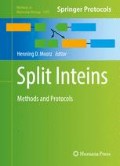Abstract
Proteins are nature’s building blocks and indispensable in living organisms. Protein-based hydrogels have a wide variety of applications in research and biotechnology. In this chapter, we describe an intein-mediated protein hydrogel that utilizes two synthetic soluble protein block copolymers, each containing a subunit of a trimeric protein that serves as a cross-linker and one half of the naturally split DnaE intein from Nostoc punctiforme. Mixing of these two protein block copolymers initiates an intein trans-splicing reaction that constitutes a self-assembling polypeptide flanked by cross-linkers, triggering protein hydrogel formation. The generated hydrogels are highly stable under both acidic and basic conditions, and at temperatures up to 50 °C. In addition, these hydrogels are able to undergo rapid reassembly after shear-induced rupture. Incorporation of an appropriate binding motif into the protein block copolymers enables the convenient site-specific incorporation of functional globular proteins into the hydrogel network.
Access this chapter
Tax calculation will be finalised at checkout
Purchases are for personal use only
References
Langer R, Tirrell DA (2004) Designing materials for biology and medicine. Nature 428(6982):487–492
Kopeček J, Yang J (2012) Smart self-assembled hybrid hydrogel biomaterials. Angew Chem Int Ed 51(30):7396–7417. doi:10.1002/anie.201201040
Banta S, Wheeldon IR, Blenner M (2010) Protein engineering in the development of functional hydrogels. Annu Rev Biomed Eng 12:167–186
Ramirez M, Guan D, Ugaz V, Chen Z (2013) Intein-triggered artificial protein hydrogels that support the immobilization of bioactive proteins. J Am Chem Soc 135(14):5290–5293
Sun F, Zhang WB, Mahdavi A, Arnold FH, Tirrell DA (2014) Synthesis of bioactive protein hydrogels by genetically encoded SpyTag-SpyCatcher chemistry. Proc Natl Acad Sci U S A 111(31):11269–11274. doi:10.1073/pnas.1401291111
Wong Po Foo CT, Lee JS, Mulyasasmita W, Parisi-Amon A, Heilshorn SC (2009) Two-component protein-engineered physical hydrogels for cell encapsulation. Proc Natl Acad Sci U S A 106(52):22067–22072. doi:10.1073/pnas.0904851106
Guan D, Ramirez M, Shao L, Jacobsen D, Barrera I, Lutkenhaus J, Chen Z (2013) Two-component protein hydrogels assembled using an engineered disulfide-forming protein-ligand pair. Biomacromolecules 14(8):2909–2916. doi:10.1021/bm400814u
Shen W, Zhang K, Kornfield JA, Tirrell DA (2006) Tuning the erosion rate of artificial protein hydrogels through control of network topology. Nat Mater 5(2):153–158. doi:10.1038/nmat1573, nmat1573 [pii]
Shen W, Kornfield JA, Tirrell DA (2007) Dynamic properties of artificial protein hydrogels assembled through aggregation of leucine zipper peptide domains. Macromolecules 40(3):689–692
Muralidharan V, Muir TW (2006) Protein ligation: an enabling technology for the biophysical analysis of proteins. Nat Methods 3(6):429–438
Zettler J, Schütz V, Mootz HD (2009) The naturally split Npu DnaE intein exhibits an extraordinarily high rate in the protein trans-splicing reaction. FEBS Lett 583(5):909–914
Iwai H, Züger S, Jin J, Tam P-H (2006) Highly efficient protein trans-splicing by a naturally split DnaE intein from Nostoc punctiforme. FEBS Lett 580(7):1853–1858
Tanaka Y, Tsumoto K, Nakanishi T, Yasutake Y, Sakai N, Yao M, Tanaka I, Kumagai I (2004) Structural implications for heavy metal-induced reversible assembly and aggregation of a protein: the case of Pyrococcus horikoshii CutA. FEBS Lett 556(1):167–174
Sawano M, Yamamoto H, Ogasahara K, Kidokoro S, Katoh S, Ohnuma T, Katoh E, Yokoyama S, Yutani K (2008) Thermodynamic basis for the stabilities of three CutA1s from Pyrococcus horikoshii, Thermus thermophilus, and Oryza sativa, with unusually high denaturation temperatures. Biochemistry 47(2):721–730
McGrath KP, Fournier MJ, Mason TL, Tirrell DA (1992) Genetically directed syntheses of new polymeric materials. Expression of artificial genes encoding proteins with repeating-(AlaGly) 3ProGluGly-elements. J Am Chem Soc 114(2):727–733
Shen W, Lammertink RGH, Sakata JK, Kornfield JA, Tirrell DA (2005) Assembly of an artificial protein hydrogel through leucine zipper aggregation and disulfide bond formation. Macromolecules 38(9):3909–3916
Shah NH, Dann GP, Vila-Perello M, Liu Z, Muir TW (2012) Ultrafast protein splicing is common among cyanobacterial split inteins: implications for protein engineering. J Am Chem Soc 134(28):11338–11341. doi:10.1021/ja303226x
Carvajal-Vallejos P, Pallisse R, Mootz HD, Schmidt SR (2012) Unprecedented rates and efficiencies revealed for new natural split inteins from metagenomic sources. J Biol Chem 287(34):28686–28696. doi:10.1074/jbc.M112.372680
Ito F, Usui K, Kawahara D, Suenaga A, Maki T, Kidoaki S, Suzuki H, Taiji M, Itoh M, Hayashizaki Y, Matsuda T (2010) Reversible hydrogel formation driven by protein-peptide-specific interaction and chondrocyte entrapment. Biomaterials 31(1):58–66. doi:10.1016/j.biomaterials.2009.09.026, S0142-9612(09)00956-9 [pii]
Lockless SW, Muir TW (2009) Traceless protein splicing utilizing evolved split inteins. Proc Natl Acad Sci U S A 106(27):10999–11004. doi:10.1073/pnas.0902964106
Dueber JE, Wu GC, Malmirchegini GR, Moon TS, Petzold CJ, Ullal AV, Prather KLJ, Keasling JD (2009) Synthetic protein scaffolds provide modular control over metabolic flux. Nat Biotechnol 27(8):753–759. doi:10.1038/Nbt.1557
Acknowledgements
This work was supported in part by the National Science Foundation CAREER award, US Air force YIP and Norman Hackman Advanced Research Program. We would like to acknowledge Dr. David Tirrell (Caltech) for his kind gift of the plasmid pQE9 AC10Atrp [16], Dr. Takehisa Matsuda (Kanazawa Institute of Technology, Hakusan, Ishikawa, Japan) for his kind gift of the plasmid pET30-CutA-Tip1 [19], Dr. Tom Muir (Princeton University) for his kind gift of the plasmid KanR-IntRBS-NpuNC-CFN [20], and Dr. Jay D. Keasling (UC Berkley) for his kind gift of the plasmid pJD757 [21].
Author information
Authors and Affiliations
Corresponding author
Editor information
Editors and Affiliations
Rights and permissions
Copyright information
© 2017 Springer Science+Business Media New York
About this protocol
Cite this protocol
Ramirez, M.A., Chen, Z. (2017). Split-Intein Triggered Protein Hydrogels. In: Mootz, H. (eds) Split Inteins. Methods in Molecular Biology, vol 1495. Humana Press, New York, NY. https://doi.org/10.1007/978-1-4939-6451-2_11
Download citation
DOI: https://doi.org/10.1007/978-1-4939-6451-2_11
Published:
Publisher Name: Humana Press, New York, NY
Print ISBN: 978-1-4939-6449-9
Online ISBN: 978-1-4939-6451-2
eBook Packages: Springer Protocols

